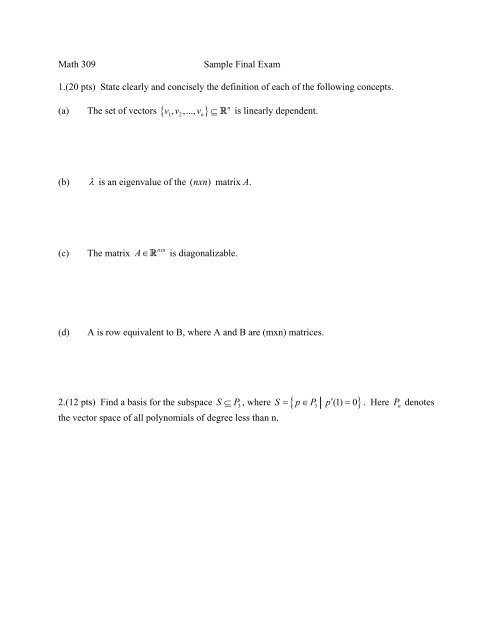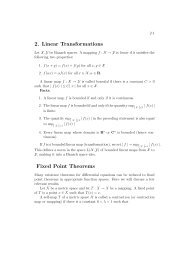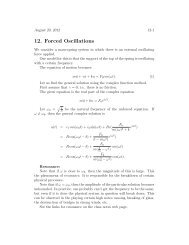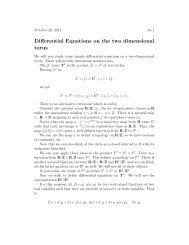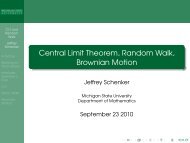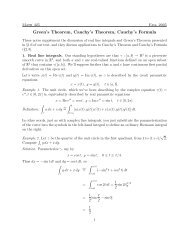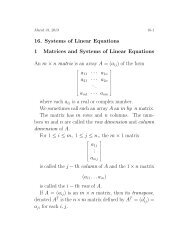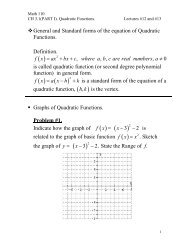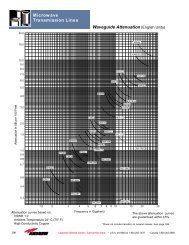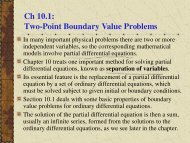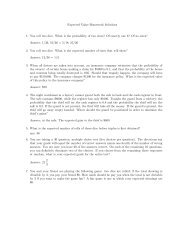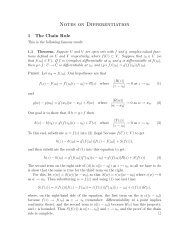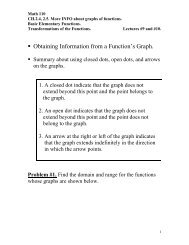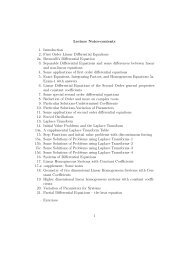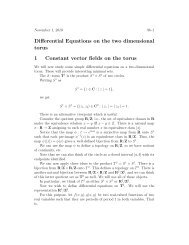Math 314 Final Exam Spring, 1996
Math 314 Final Exam Spring, 1996
Math 314 Final Exam Spring, 1996
Create successful ePaper yourself
Turn your PDF publications into a flip-book with our unique Google optimized e-Paper software.
<strong>Math</strong> 309<br />
Sample <strong>Final</strong> <strong>Exam</strong><br />
1.(20 pts) State clearly and concisely the definition of each of the following concepts.<br />
(a) The set of vectors { , ,..., }<br />
n<br />
v1 v2<br />
vn<br />
⊆ R is linearly dependent.<br />
(b) λ is an eigenvalue of the ( nxn) matrix A.<br />
(c)<br />
The matrix<br />
nxn<br />
A∈R is diagonalizable.<br />
(d)<br />
A is row equivalent to B, where A and B are (mxn) matrices.<br />
2.(12 pts) Find a basis for the subspace S P 3<br />
, where S = p∈ P3 p′ (1) = 0 . Here P n<br />
denotes<br />
the vector space of all polynomials of degree less than n.<br />
⊆ { }
⎡1 2 −1 1⎤<br />
3.(24 pts) Given that A =<br />
⎢<br />
2 4 −3 0<br />
⎥<br />
has row echelon form<br />
⎢<br />
⎥<br />
U<br />
⎢⎣1 2 1 5⎥⎦<br />
⎡1 2 −1 1⎤<br />
=<br />
⎢<br />
0 0 1 2<br />
⎥<br />
⎢ ⎥<br />
⎢⎣<br />
0 0 0 0⎥⎦<br />
(a) Find a basis for the null space of A.<br />
(b) Find a basis for the range of A.<br />
(c) Find a basis for the row space of A.<br />
(d) Determine rank ( A)<br />
.<br />
4.(28 pts) True or false. Please explain your answer.
(a) If A = BC where B is nonsingular, then rank( A) = rank( C)<br />
.<br />
4<br />
(b) If A is (4x3) and rank( A) = 3 , then Ax= b is solvable for any b∈<br />
R .<br />
(c)<br />
There exist (2x2) matrices A and B such that both A and B are singular, but<br />
AB is nonsingular.<br />
k<br />
(d) If A is an (nxn) matrix for which A = 0 for some k >1, then A is singular.<br />
5.(20 pts) For each of the following, if U is a subspace of V, verify the subspace criteria. If U is<br />
not a subspace of V, explain precisely why not.<br />
nxn<br />
(a) U = all (nxn) nonsingular matrices, V = R .<br />
nxn<br />
(b) U = all (nxn) symmetric matrices, V = R .
6.(10 pts) Let { x , , 1<br />
xn}<br />
{ x x }<br />
be an orthonormal set in an inner product space V. Prove that<br />
, , 1<br />
<br />
n<br />
is linearly independent.<br />
nxn<br />
7.(10 pts) Let A,<br />
B∈R . If A is diagonalizable and B is similar to A, prove that B is also<br />
diagonalizable.<br />
8.(16 pts) Which of the following matrices are diagonalizable and which are not. Please give
oth an answer and a reason.<br />
(a)<br />
⎡2 2 1 ⎤<br />
⎢<br />
0 1 2<br />
⎥<br />
⎢ ⎥<br />
⎢⎣0 0 −1⎥⎦<br />
(b)<br />
⎡2 −1⎤<br />
⎢<br />
0 2<br />
⎥<br />
⎣ ⎦<br />
3<br />
9.(16 pts) Consider the linear transformation L:<br />
P → P<br />
4 defined by L( p)( x) = xp( x)<br />
. Find the<br />
matrix which represents L relative to the bases { 2<br />
2 3<br />
1,1 −x,1<br />
− x+ x } in P<br />
3<br />
and { 1, x, x , x } in P 4<br />
.
10.(20 pts) Given the data, find the equation of the line y= a0 + a1x<br />
which best fits the data in<br />
the least squares sense.<br />
x 0 3 6<br />
y 1 4 5<br />
⎡1 1 1⎤<br />
11.(14 pts) Given A =<br />
⎢<br />
1 0 1<br />
⎥<br />
, factor A into a product QR, where Q is orthogonal and R is<br />
⎢⎢ ⎥<br />
⎣0 1 1 ⎥ ⎦<br />
upper triangular and nonsingular.
⎡2 −3⎤<br />
12.(10 pts) The matrix A = ⎢ has eigenvalues<br />
⎣2 −5<br />
⎥ λ<br />
1<br />
= 1 and λ<br />
2<br />
= − 4 . Find the<br />
⎦<br />
corresponding eigenvectors.


